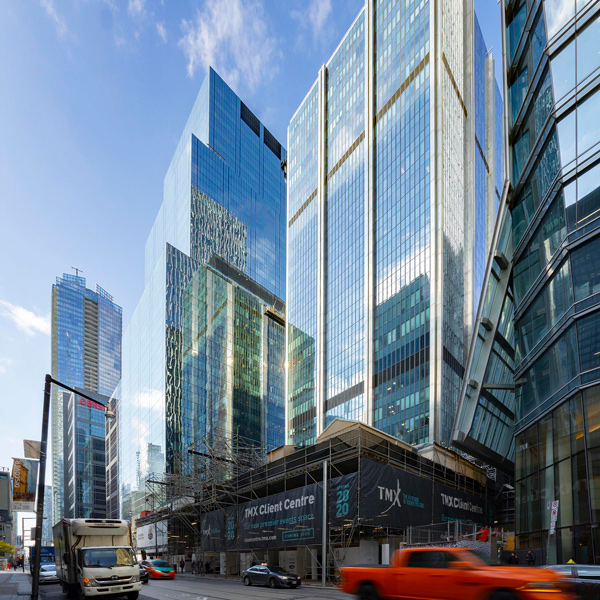Recladding large-scale commercial buildings has shifted from an emerging market in Toronto to one that is increasingly on solid ground, a sector becoming familiar to architectural firms such as WZMH Architects.
Chalk the evolution up in part to advancements in curtainwall technology meeting up with an aging commercial building stock.
Harrison Chan, principal at WZMH, says the cladding on a number of commercial buildings from the 1970s and even ’80s is nearing end of life or needing major repair. Increasingly, owners are evaluating their buildings to improve energy performance and to possibly rebrand in the competitive office market.
One of WZMH’s projects is an office tower at 95 Wellington, a 320,000 square foot project in downtown Toronto that is being reclad in polished white granite. The building had “issues with some of the (spandrel) clips,” he says.
The original framing and glass will remain on the building, the architect points out, noting most of the framing he sees on 40 to 50-year-old commercial buildings remains “very robust, even in the anchoring into the slab.”
But there are problems cropping up in aging curtainwalls and among the major issues Chan sees are seal failures in the insulated glass, waterproofing membrane breakdowns and in some instances the backpans in spandrels have developed cracks that cause leaks into the building.
The architect says metal panel deterioration and some backpan failures were why the existing metal panels were switched out to glass on two office towers at 120 and 130 Adelaide completed about a year ago in Toronto’s core.

It is not news that today’s cladding systems have significant energy efficiency benefits over 40-to-50-year-old curtainwalls. Modern insulated glass, for example, features low e-coatings that help with UV and solar heat-gain co-efficiency to improve glass performance, Chan says.
But what is news is that glass technology is reaching new heights and architectural firms such as WZMH are keeping an eye on a recent innovation: vacuum insulating glass (VIG) manufactured by several companies globally.
Art Huard of Toronto-based GlassCan, a building envelope specialist in the glass and glazing industry, says VIG can provide close to four times the R-value that conventional glass offers.
He says VIG employs the same principles as insulated thermos bottles to prevent the conduction and convection of heat through the glass.
Typically, modern commercial glazing in Toronto consists of two lights of six-millimetre (mm) glass, an air gap of 12.5 mms, a Low e-coating and possibly filled with argon gas to achieve an R-value of about four, he says. By comparison, VIG employs only a thin vacuum space between the two glass lights to achieve an R-value of close to 15.
“In my 46 years in the glass business this is by far the most revolutionary product I’ve ever seen. It’s going to change the world,” says Huard, noting VIG will be specified for the first time in North America on a large office building in the U.S.
There are several manufacturers in Asia and Europe producing VIGs but Huard says he is working with a team of investors to build the first factory in North America.
While new cladding can help improve a building’s energy performance, Chan says it is important to look at upgrades to the building as a whole. That includes to mechanical systems.
“It’s been challenging to get that integrated as part of the cladding work.”
WZMH is working on several projects in Toronto, including 76 Adelaide which is just starting construction.
“It will be an extremely different cladding look that hasn’t been seen in Toronto.”
The list of contractors able to take on large-scale commercial recladding is not large, but it is growing, he says, adding a training course on recladding that would include a building mock-up would be “a beneficial learning experience” for the building trades.
At 120-130 Adelaide, a two-floor in-situ mockup was done prior to the project’s start but mockups are not done commonly.
He says while every renovation project has its own challenges, some common hiccups include vertical curtainwall panels not matching up to joints. That points to either an installation or structural issue.
The architect says it is difficult to determine how big the recladding market could become over the next decade, partly because some buildings are performing well even beyond their expected end of life cycles.
“I think the ones in the ‘70s range that are strictly curtainwall are the ones we anticipate coming down the pipe requiring additional work beyond just repairs. There are a sizable number (in downtown Toronto) and different scales as well.”











The remodel process is certainly becoming a bigger and bigger factor for us. Some of the glass in older buildings in the US is 1/4 (6mm) monolithic. the older sealant and gasket designs are failing. Anchors on many of the buildings that we have done are still sufficient for todays loads as they were probably over designed in the beginning. the actual framing members may also still be good. We have developed a way to put new insulated units in with supplemental framing that provides a high performance air, water and thermal barrier sometimes without moving people out of their workspaces. it’s the thing to come and we at Accura Systems are excited about it.
Important to note that the buildings were clad originally from the floor slab out through open windows or un framed upper floors and droppe down by chainfall, manually, to installers working from a swing stage , with all that entails. Now the electric full elevation platform allows installs and retrofits so buildings can be clad while free of fall arrest equipment and liflelines etc.
Also, all material loaded at ground floor and hoisted up to the floor you are cladding on these modern platforms, from the outside, with more than two installers on these same platforms, as opposed to loading on site skips aka elevators by pump buggy, offloading, staging, chainfalling out off the floor slab, installing waterproofing and air seals, then insulate, then install the finish face of the assembly, then caulk the whole facade, all done from a 24 inch platform attached to beams and rigging supported by counterweights on the roof. The first day of set up entailed carrying 20kilo swing stage beam counter weights up to the roof level by stairs!! one in each hand if you wanted your back to survive to keep your spine straight!!! 8 weights per beam !! Granite cladding like Scotia Plaza is unmatched in its beauty and sustainability!! Also done by swing stage.